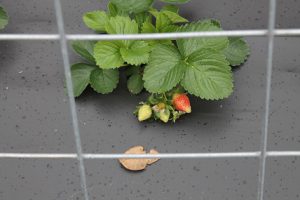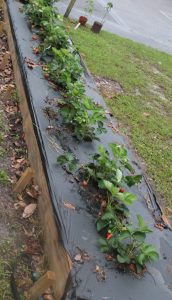
Strawberries growing on “plastic” to protect them from water splashed fungal spores found in soil. Image Credit: Matthew Orwat UF/IFAS Extension Washington County
As the alternating cycles of sun, heat and rain shape our summer days, I start thinking about cooler times of the year, the fall planting season. One plant to consider planting in the fall are strawberries. Planting strawberries in the fall is really an exercise in preparation for bountiful production of fruit beginning in January and continuing into May and June. The following procedure will lead to a successful strawberry production if followed!
The best location for strawberry production provides well-drained, moist, sandy soil with substantial organic matter. It must not be too wet. pH should be between 5.5 and 6.5, which is considered slightly acidic. A fertilizer scheme of 2 lbs. of a 10-5-10 fertilizer per 100 sqft of raised bed or 10 feet of row should be applied at pre-plant, with ¼ of the fertilizer over the top and the rest in a one-inch-deep band near the location of drip irrigation.
*DO NOT apply fertilizer directly below the plants, as the fertilizer may burn the young transplants.

This is a raised bed of strawberries, which has been filled with rich composted growing media. Image Credit: Matthew Orwat UF/IFAS Extension Washington County
Commonly, a preferred system is the development of a hill system, which is 6-8 inches high and 24 inches wide. Drip irrigation should be installed for best results, thus keeping the leaves free of irrigation water. This hill should be covered with weed barrier, such as grower’s polyurethane plastic to reduce weed growth and soil splashing onto leaves. Additionally, strawberries do well when planted in a raised bed. This system can still utilize weed barriers and drip irrigation but gives the gardener the added benefit of manipulation of the growing media. Growing media made up of compost and coconut coir works especially well for this and may be found at local large garden centers.
Short day cultivars that have been proven to do well for home gardeners in Northwest Florida production are Sweet Charlie and Camarosa and should be purchased certified disease free from a reputable nursery. Both dormant bare root and actively growing plug plants are available for purchase, but I have had best luck with actively growing plug transplants.
While strawberry plants can easily withstand our winter temperatures, fruit can suffer damage from frosts below 32 degrees Fahrenheit. The good news is that small row covers or “low tunnels” can be constructed to prevent fruit loss and encourage early fruiting.
When setting out the transplants:
- Keep plants moist before planting
- Spread roots out in fan-shape
- Set plants in moist soil at the correct depth. Do not cover the plants crown with dirt or leave its roots exposed above the soil.
- Space plants 12 to 18 inches apart.
- Pack the soil firmly around the roots, then sprinkle with water. Overhead sprinkling may keep the tops from drying out until the roots can get established.

Homemade row cover for strawberries made of cow panels and sheets. Commercial row covers can be purchased using hoops and frost cloth. You can also make your own with pipes and bulk rolled frost cloth. Image Credit: Matthew Orwat UF/IFAS Extension Washington County
As stated above, strawberries should be mulched. Black polyethylene plastic mulch at 1 to 1½ mil thick is best (completely cover the top and sides of bed before planting). Be sure the bed is firm, formed correctly, moist, and fertilized adequately. Place soil on the edges of the plastic to hold it in place. Cut slits in the plastic for the transplants.
When using alternatives like straw, bark or other natural organic materials mulch to a depth of 1 to 2 inches, but do not completely cover the plant.
For more information, Please consult these references or contact your local extension agent:
Growing Strawberries in the Florida Home Garden
Strawberry Cultivars Recommended by UF / IFAS Extension Specialists
The UF / IFAS Strawberry Plant Breeding Program
- Woodland Pinkroot Adds Vibrant Color to Spring Landscapes - April 27, 2023
- Easy Care Roses for the Gulf South - April 20, 2023
- Herb Gardening: When Oregano is Flavorless - March 9, 2023
